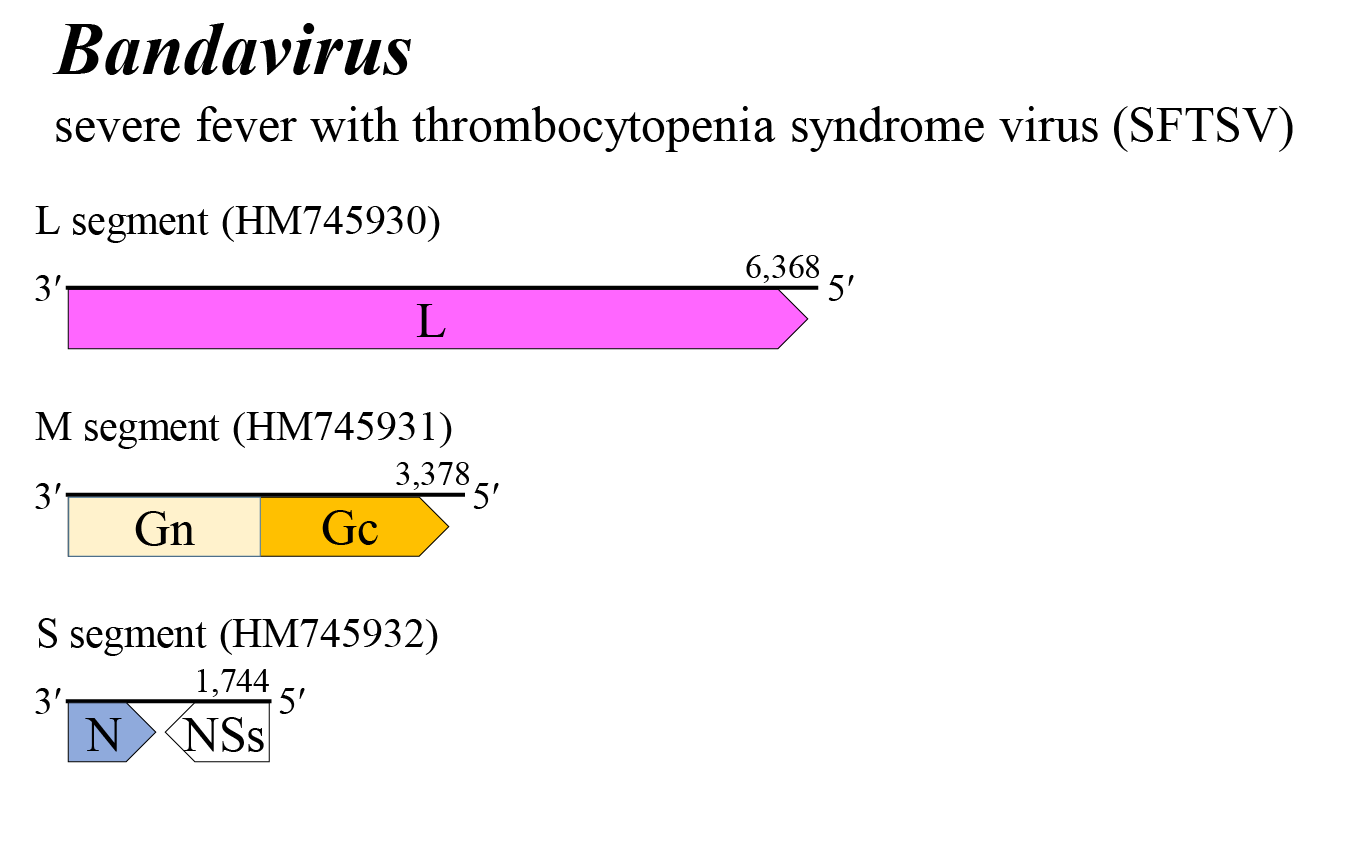Family: Phenuiviridae
Genus: Bandavirus
Distinguishing features
Nine bandaviruses are assigned to the genus Bandavirus. Bandaviruses infect mammals including human and birds, and are transmitted by ticks. The bandavirus genome has five genes, encoding a large protein (L), two external glycoproteins (Gn and Gc), a nucleocapsid protein (N), and a non-structural protein (NSs), similar to the genome arrangements of mobuviruses and uukuviruses. Based on well-supported Maximum Likelihood or Maximum Clade Credibility trees inferred from complete L protein sequences, viruses classified in the genus Bandavirus form a monophyletic cluster clearly distinguished from other phenuivirids (Yu et al., 2011, Matsuno et al., 2013, Elliott and Brennan 2014).
Virion
Morphology
Enveloped virions are spherical or pleomorphic, 80–120 nm in diameter, and have surface glycoprotein projections of 5–10 nm which are embedded in a lipid bilayer envelope approximately 5 nm thick.
Nucleic acid
The bandavirus genome encompasses three segments of negative-sense or ambisense RNA. The terminal nucleotides of each segment occur in a canonical, conserved sequence (in coding sense) 5′-ACACAGAGAC… GUCUUUGUGU-3′ and may form the panhandle structures typical of other members of the class Bunyaviricetes (Table 2 Phenuiviridae). The L segment (6.3–6.4 kb) encodes a protein with a predicted molecular mass of 235–237 kDa with an RNA-directed RNA polymerase (RdRP) domain homologous with that of other bunyavirals. The M segment (3.3–3.4 kb) encodes a protein of 101–119 kDa that is homologous with the phlebovirus glycoproteins G1 and G2 including the C-terminal Ig-like domain. The S segment (1.4–3.3 kb) encodes proteins of 27–28 kDa and 31–36 kDa that are homologous with the N domain of tenuiviruses and phleboviruses, and to the non-structural protein of Rift Valley fever virus, respectively (Table 3 Phenuiviridae).
Genome organization and replication
Bandavirus genome arrangement is similar to that of mobuviruses and uukuviruses (Figure 1 Bandavirus). The L, M, and S segments encode L, the glycoprotein precursor (comprising Gn and Gc), and N, respectively. The Gc and Gn glycoproteins of 47–64 kDa and 54–56 kDa were earlier referred to as G1 and G2 based on apparent size on gel electrophoresis. The S segment exhibits an ambisense coding strategy with two ORFs, N and NSs, separated by a noncoding intergenic region that potentially forms a long A/U rich stem-loop structure. (Yu et al., 2011, Matsuno et al., 2013, Swei et al., 2013). Replication, morphogenesis, assembly, and budding are described in ‘Genome organisation and replication’ on the family page.
 |
| Figure 1 Bandavirus. Genome organization of bandaviruses. Coloured boxes depict ORFs that encode N, nucleocapsid protein; Gn and Gc, external glycoproteins; and L, large protein. A white box depicts an ORF that encodes NSs, non-structural protein. |
Biology
Host range
Bandaviruses have been in the spotlight in China and USA as causes of emerging infectious diseases of humans since the 2000s. The major clinical symptoms/signs included fever, thrombocytopenia, gastrointestinal symptoms, and leukocytopenia, and there was an unusually high initial case fatality rate of 30%. Bandaviruses infect mammals and birds and are transmitted by ticks. Host ranges of bandaviruses are cattle, sheep, goats, mice, four-toed hedgehogs [Atelerix albiventris (Wanger, 1841)], striped ground squirrels [Euxerus erythropus Desmarest, 1817], shy albatrosses [Thalassarche cauta (Gould, 1841)], woodchucks [Marmota monax (Linnaeus, 1758)], and humans. Several bandaviruses cause fever and affections of the central nervous system in young ruminants/or have been associated with a severe and sometimes fatal febrile illness with thrombocytopenia and hemorrhagic manifestations in humans (Hubálek 2009, McMullan et al., 2012, Elliott and Brennan 2014, Muehlenbachs et al., 2014, Wang et al., 2014).
Transmission
Bandaviruses are transmitted by particular species of ticks in a circulative, propagative manner. The major vectors are the ticks Dermacentor marginatus (Sulzer, 1776), D. nuttalli (Olenev, 1928), Ixodes cornuatus (Roberts, 1960), Rhipicephalus decoloratus Koch, 1844, and R. pulchellus (Gerstäcker, 1873). Bandaviruses can be transmitted transovarially by virus-infected female ticks to their offspring, and through sperm from virus-infected males. In addition to transmission by arthropod vectors, mammals can become infected through contact with the blood or body fluids of infected animals. Person-to-person transmission has also been reported among people caring for infected patients (Dilcher et al., 2012, Savage et al., 2013, Elliott and Brennan 2014, Wang et al., 2014).
Species demarcation criteria
The criteria demarcating species in the genus are:
• Less than 95% identity in RdRP amino acid sequence.
Related, unclassified viruses
| Virus name | Accession number | Virus abbreviation |
| Forécariah virus | L: JX961625; M: JX961626; S: JX961627 | FORV |
| Malsoor virus | L: KF186497; M: KF186498; S: KF186499 | MalV |
| Palma virus | L: JX961628; M: JX961629; S: JX961630 | PALV |
Virus names and virus abbreviations are not official ICTV designations.

